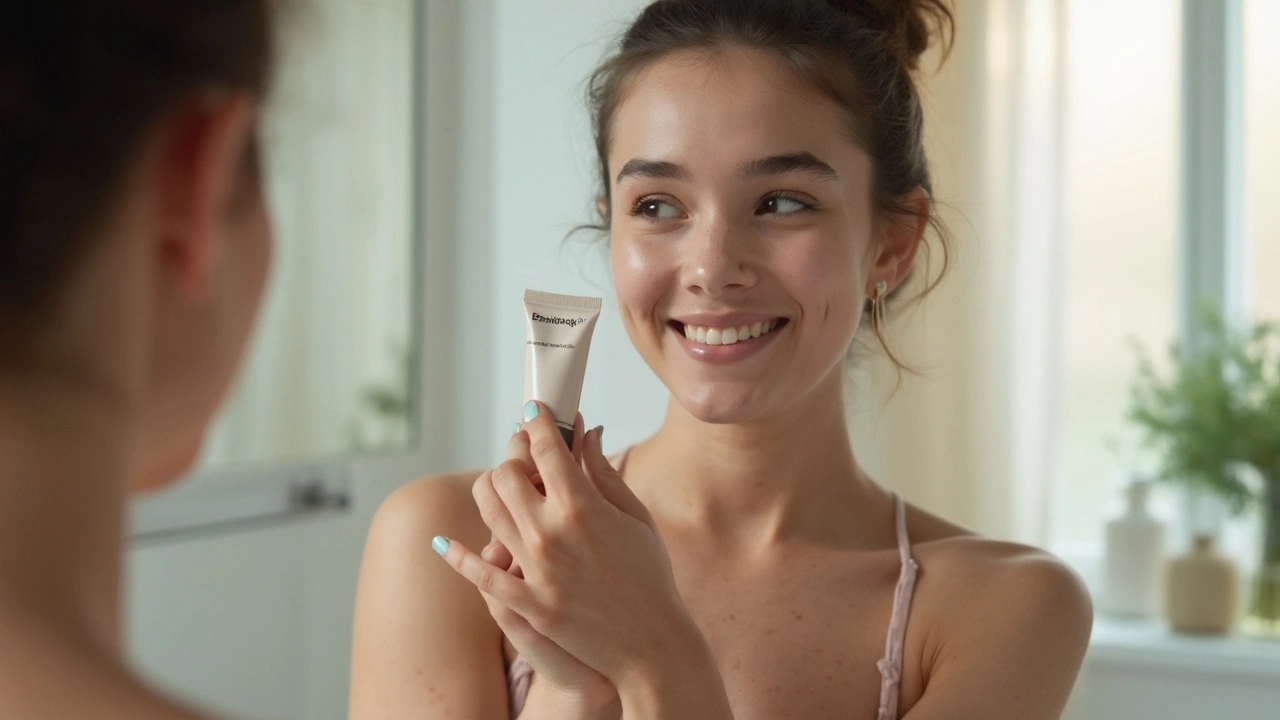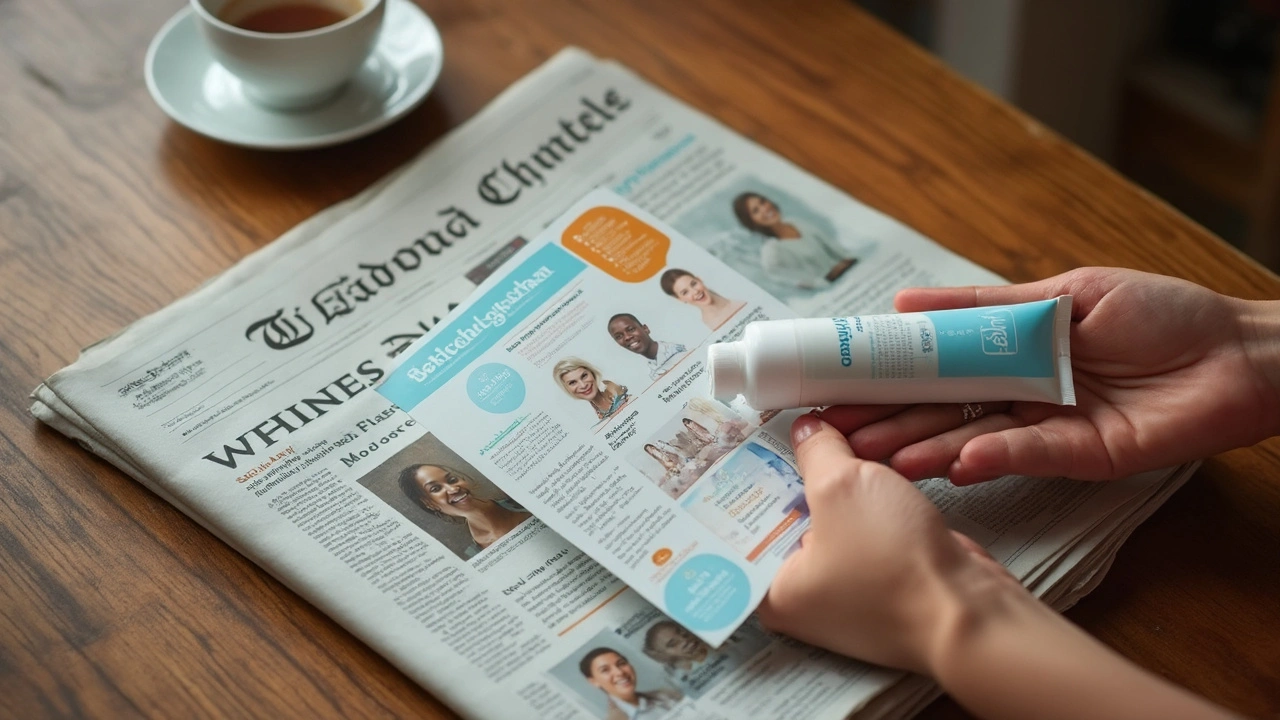Benoquin Cream: Uses, Effects, and What to Expect Before Trying It
 Jun, 21 2025
Jun, 21 2025
Did you know there’s a cream so effective at removing skin pigment that it was actually designed for people with uneven skin colour because of a medical condition? That’s where Benoquin Cream comes in, stirring up all kinds of opinions online and in dermatology offices. Whisper the name “Benoquin” to anyone who’s wrestled with stubborn patches of vitiligo and you’ll most likely get an eyebrow raise and a story. This isn’t your average moisturiser, and it’s definitely not something to pick up for a casual skin routine tweak. The Australian TGA keeps a close eye on it, and so do doctors. Still, its reputation for powerful results keeps curious people coming back with questions—and sometimes unrealistic expectations.
What Exactly Is Benoquin Cream?
If you trawl through Google for solutions to permanent skin discoloration, inevitably Benoquin Cream pops up. The active ingredient is Monobenzone. This isn’t your everyday skin lightener or even a typical treatment for patchy skin—it’s basically designed to wipe out melanin (that pigment that gives your skin its colour) wherever the cream goes. Monobenzone is unique: it causes permanent loss of colour in the areas you apply it, making it the go-to option when someone with vitiligo wants their naturally darker patches gone for good. The idea? Instead of treating random spots, you even everything out by depigmenting the rest of your skin. It’s kind of like a reset button for melanin, except for people struggling with widespread or stubborn vitiligo, not for beauty trends.
The cream usually comes in 20% concentration in most countries, including Australia, and is prescription-only. The science is direct: Monobenzone enters skin cells (melanocytes) and wipes out their ability to produce melanin. What’s left is lighter (or eventually white) skin that won’t tan even under the wild Perth sunshine. Unlike hydroquinone—a popular fading agent found in other creams—Monobenzone doesn’t gently fade areas. It bulldozes, leaving no pigment behind if used as prescribed.
Anyone hunting for cosmetic skin lightening usually finds out pretty quickly that this isn’t a product doctors hand over unless there’s a solid medical reason. The ingredient can cause unpredictable results if used by people without vitiligo. Going off-label comes with real risks, from permanent, untreatable whitened patches to severe skin irritation. As of June 2025, it’s still not recommended for cosmetic use, and Australian regulations are clear on that.
Who Actually Needs Benoquin Cream?
People with vitiligo are usually the only group Benoquin Cream was ever meant for. Vitiligo causes patchy, uneven loss of pigment in the skin. Sometimes, different body areas turn stark white while the rest keeps its natural colour, which can feel even more visible for people with darker complexions. For some, the spread is so wide that trying to return pigment to small patches isn’t realistic. Benoquin steps in for cases like this. Rather than treating each patch, doctors sometimes suggest making all of the skin match the lighter shade. That way, instead of blotches, you get a more uniform appearance.
But not everyone with vitiligo should use it. Usually, dermatologists only recommend it if over 50% of a person’s body is depigmented, the patches are stable (not spreading fast), and nothing else has worked. If you’ve wondered why some celebrities with vitiligo have absolutely even-toned skin, this approach is sometimes the reason. Although rare, there are other skin conditions—like chemical depigmentation from burns—where it’s considered as a last resort. For kids, pregnant women, or those with really sensitive skin, doctors steer clear. And let’s not gloss over that this is permanent—once it’s gone, it’s gone. Tanning’s off the table forever, and sunburn risk jumps.
It’s a highly emotional decision, and everyone’s reasoning is deeply personal, depending on culture, lifestyle, and visibility. Many feel more confident once all skin matches, while others find the process so slow and unpredictable that they give up halfway. In all cases, the cream should never be used without ongoing doctor supervision.

How to Use Benoquin Cream Safely and What to Expect
The process of depigmenting with Benoquin Cream isn’t a weekend experiment. You’re looking at months of careful application. Typically, a dermatologist will have you apply it sparingly to the affected areas up to twice daily. Progress is slow—the first signs of skin lightening may appear after four to six weeks, but total depigmentation can take 6 to 12 months or longer depending on how your skin reacts. The most important part? Patience, and strict sun avoidance. You’ll want full-spectrum sunscreen with a high SPF (50+) every day, even if you’re only popping out to the shops. Hats, sleeves—the whole lot become wardrobe staples, especially under the fierce Australian sun.
Here’s a peek at what the treatment journey can look like:
- Month 1-2: Patches might start fading unevenly, with lighter spots showing up first.
- Month 3-6: Larger areas lose pigment, but you might notice some areas hold on to melanin stubbornly.
- By 1 year: Most people reach their goal, but some experience uneven lightening that needs touch-ups or adjustment by a pro.
Doctors watch for reactions like redness, rashes, itching, or irritation. Allergic reactions aren’t common, but they do happen. Since Monobenzone triggers an immune response, in rare cases untreated areas can also lose pigment (this is called "remote depigmentation"). That’s why the cream gets respect.
Stopping partway through often leads to a patchwork effect that’s difficult to fix. If people ignore the doctor’s instructions, apply the cream to the wrong spots, or skip sun protection, they end up with an odd checkered appearance and, occasionally, severe sunburns. If you’re someone who doesn’t like routines, this cream might not work out. Tell your dermatologist about any history of allergies or skin sensitivities before starting.
Benoquin Cream Facts and Safety Insights
There’s a lot of dodgy information swirling online. Some sites claim Benoquin can be used like an all-over skin bleaching agent, but that’s both illegal and dangerous in Australia. Since this is a medication, not a cosmetic, it requires a prescription and close medical follow-up. Here are key facts to keep in mind:
- It’s not approved for spot removal of dark marks or freckles—only for depigmenting in widespread vitiligo.
- The depigmentation is usually permanent. Some pigment may return in very rare cases, but patches are common if the skin is exposed to sun or if you stop treatments too early.
- Using it for general skin lightening or fashion? It’s both unsafe and illegal to buy it online for cosmetic use, with customs cracking down on imports.
- Always patch test. Dermatologists recommend applying to a small area for 1–2 weeks to check for reactions before going larger.
- Mixing with other bleaching creams can irritate the skin further, and doctors usually advise against it.
Let’s put some real numbers to things—here’s a table from a 2024 review summarizing typical side effects and estimated frequencies based on patient reports:
| Side Effect | Estimated Frequency (%) |
|---|---|
| Skin irritation | 25 |
| Itching or burning | 20 |
| Remote pigment loss (unintended areas) | 8 |
| Allergic dermatitis | 3 |
| Sun sensitivity | 80+ |
Doctors are quick to point out that if you have a reaction, it’s often no big deal—stop using the cream and call up your dermatology clinic. Most issues clear up with basic care and maybe a soothing steroid topical. Still, long-term use and over-application can trigger bigger problems like scarring or deep cracks in the skin, especially on delicate areas like eyelids and genitals.
As for storage, keep the cream in a cool place out of reach of kids and pets. Heat can degrade the active ingredient, making it less effective or causing it to separate.

Tips, Alternatives, and Dealing with the Emotional Side
Vitiligo can affect everything from your wardrobe to your confidence, especially here in sunny places like Perth, where shorts and sleeveless tops are almost compulsory. For people thinking about Benoquin—or those mid-process—it helps to know there are solid coping tools and alternatives if the cream feels too drastic or the risks seem too high.
- Use camouflage makeup: High-coverage makeup designed for vitiligo can mask uneven areas temporarily. Look for waterproof and sweat-resistant options.
- Phototherapy: Techniques like narrowband UVB can sometimes help repigment patches, especially early on.
- Topical corticosteroids or calcineurin inhibitors: These can slow pigment loss or prompt some new pigment in smaller areas.
- Acceptance therapy and counselling: Sounds fluffy, but for some, reframing how they see their skin makes a big difference. Joining a support group (even online) can help.
- Sunscreen is a must for all: Pigment-free skin burns fast and badly, so SPF is non-negotiable.
It’s easy to forget the mental side of skin conditions. People using Benoquin often go through frustration during treatment—progress can be slow or uneven, and the visible changes draw questions (sometimes rude ones) from others. Having a solid support network, whether friends, family, or a sympathetic doctor, helps a lot. Many feel relief at having even skin but anxiety about explaining their new look to friends, coworkers, or random strangers. If you’re starting treatment, talk to your GP or dermatologist about how to handle the attention and support your mental health along the way.
If you see ads promising fast, flawless results or “safe” at-home bleaches with Monobenzone, steer clear. Only compounds from a licensed pharmacy and prescribed by a doctor are legal and safe in Australia as of 2025. No shortcuts are worth the scars or regrets.
Still wondering if it’s for you? Jot down your questions and set up a dermatology review—many have free patient advisers. There are good solutions out there, both medical and cosmetic. The key is making an informed, safe choice—because there’s nothing casual about wiping out your melanin for life.

Carlise Pretorius
July 19, 2025 AT 08:13I've had a bit of experience with depigmentation creams, and Benoquin seems pretty effective for sure. It's wild how it actually works to lighten the skin by targeting pigment cells, right? Not gonna lie tho, I hear some people can get irritation or redness, so def be careful with it.
But hey, if you're dealing with vitiligo or want that lightening effect, it sounds promising. Just wish there was a clearer view on how long it typically takes before you see visible results. Anyone else tried it and can share their timeline?
Also, it'd be helpful to know about any dos or don’ts while using it, like sun exposure or stuff. Not sure if you gotta avoid certain creams or makeup.
Johnson Elijah
July 21, 2025 AT 20:19Yo this cream sounds dope for those struggling with pigment irregularities! 👏 It's great to get options beyond heavier procedures.
That said, side effects can be a punch, so gotta weigh pros and cons. A lot of folks forget that skin treatments can mess with your natural barrier too.
What I'm wondering is how Benoquin stacks against other depigmentation treatments like hydroquinone or even laser therapy. Anyone have insights on that? 🤔
Big ups for sharing this info tho! More awareness always helps people make informed decisions.
Roxanne Lemire
July 24, 2025 AT 08:26i read about it some time back but got worried about the impact on my skin since its so sensitive to most stuff. the article helped me see it’s not just some random cream but has sort of q scientific backing which is comforting.
like i guess any skin treatment has risks but if it’s done under doctor’s advice, probs gonna be more safe right?
also what kinda followup care is needed after using this? like do you have to keep avoiding sunlight etc
Alex Mitchell
July 26, 2025 AT 20:33This is an interesting topic that needs more open talk honestly. I appreciate the breakdown of uses and expectations—it clears up a lot of myths around skin lightening products.
I like how Benoquin works at the cellular level by affecting melanin, but it’s crucial to approach with caution, especially for folks with underlying skin conditions. Have to stress the importance of patch tests before full use.
Just curious, how long does it typically take for skin to even out in tone after regular application? Is the effect permanent or does it require continuous use?
Narayan Iyer
July 29, 2025 AT 08:39From a biochemical perspective, Benoquin’s active ingredient really targets tyrosinase inhibition which stymies melanin synthesis—essentially pigment production drops off gradually. Pretty fascinating!
However, users must be aware of the potential rebound hyperpigmentation once treatment stops, it’s an important caveat not everyone talks about. Also, layering it with sun photoprotection is absolutely critical because depigmented areas are super vulnerable.
Does anyone here incorporate antioxidants or moisturizers alongside Benoquin to mitigate irritation? I feel a combo skincare approach might optimize outcomes.
Amanda Jennings
July 31, 2025 AT 20:46I just want to add, it's super important to set realistic expectations. Sometimes people want instant fixes and products like Benoquin take consistent effort over weeks or even months.
Also, the emotional aspect of dealing with vitiligo or pigment issues is so often overlooked. Finding a supportive community or forums while trying such treatments can really boost morale.
Just remember to listen to your skin and consult experts, you’re your own best advocate! Sending positive vibes to all dealing with these challenges 💪
alex cristobal roque
August 3, 2025 AT 08:53Hey folks, for a little background: Benoquin, containing monobenzone, is quite potent and works by permanently depigmenting skin areas in vitiligo cases that have widespread depigmentation. However, it’s not a cosmetic lightener and can cause irreversible changes, so consultation with a dermatologist is key.
Several studies show that it’s mostly used when vitiligo patches are extensive and other therapies have failed or are not feasible. It’s definitely not a first-line for small pigment concerns.
And it can definitely cause irritation or inflammation, so careful skin monitoring during treatment matters. Sunscreen and moisturization help offset some adverse effects.
Anyone using it please be cautious and keep in touch with health pros!
Bridget Dunning
August 5, 2025 AT 20:59This treatment provides a truly transformative approach for those suffering from vitiligo, particularly in terms of improving psychological wellbeing by achieving color uniformity.
The jargon around melanin synthesis inhibition can be perplexing, but it’s vital to grasp these nuances to appreciate the mechanism of action. One must heed medical guidance stringently, to balance efficacy and safety.
It’s advisable that patients also receive clear instructions on photoprotection measures and skin care regimens to mitigate adverse reactions.
Have others found success in combining Benoquin with supportive therapies like UV laser or moisturizers?
Shweta Dandekar
August 8, 2025 AT 09:06Honestly, I think people need to be very cautious about rushing into skin lightening products like Benoquin, especially because of potential irreversible damage!!!
There is a moral responsibility to educate users about side effects and ensure that it’s not misused as a mere beauty cream for lighter skin tone, which is frankly troubling!
Vitiligo treatment is a medical issue, not a trend!!! Anyone considering it should get professional advice and understand ALL the risks beforehand.
Gary Smith
August 10, 2025 AT 21:13Look, the whole skin lightening market is a giant mess fueled by weird societal pressures, and Benoquin just adds to the confusion of what's pharma and what's cosmetic. We should question the motives behind marketing such treatments aggressively!!
Plus these things can be loaded with chemicals that mess with your body in ways not shown upfront!!! Always read the fine print and demand transparency.
I’m skeptical about many of these products’ safety claims, tbh.
Dominic Dale
August 13, 2025 AT 09:19There’s a lot NOT being said about potential long-term effects with these depigmentation products. They mess with your skin’s natural biology — are we sure there aren't bigger unknown consequences lurking? The ‘science’ could be hiding uncomfortable truths.
Also, why is there no talk about who funds these studies or possible pharma conflicts of interest. Must always question the narrative!!!
People should proceed carefully, can't blindly trust all these ‘safe and effective’ claims that come from interested parties.